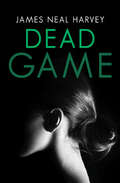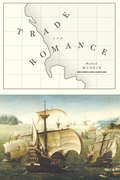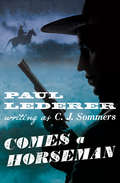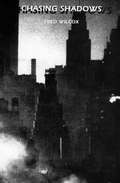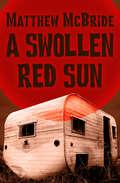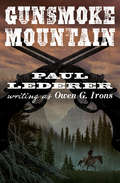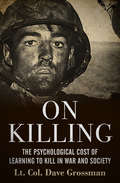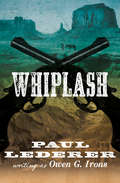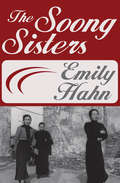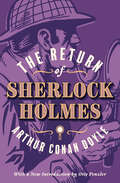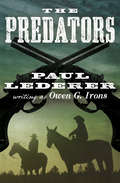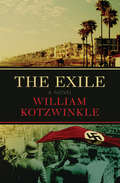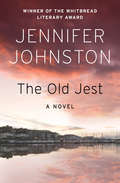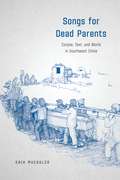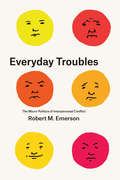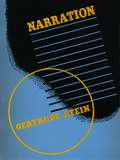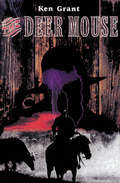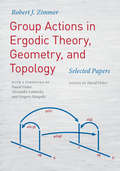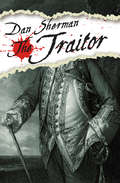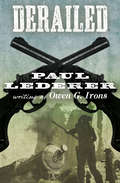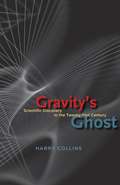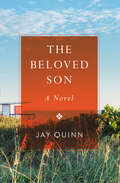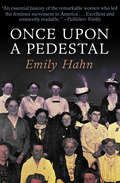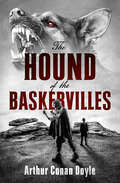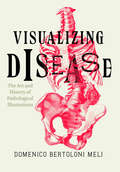- Table View
- List View
Dead Game (The Ben Tolliver Mysteries #5)
by James Neal HarveyFramed for murder, NYPD detective Ben Tolliver confronts a brilliant serial killerRazek gets into Jan&’s apartment by pretending to deliver flowers. Once she opens the door, the game is already over. He pushes his way in, pistol in hand, and tells her that he has not come to rape her; he just wants to make love. At gunpoint, she makes drinks, puts on music, and finally disrobes as Razek fights to ignore the voice in his head that tells him to kill her. Of course, the voice always wins in the end.Before he leaves, Razek plants evidence around the apartment implicating NYPD detective Ben Tolliver. Razek is a game player, and he thinks it would be fun to frame a cop for murder. To keep himself out of jail and avenge the murdered woman, Tolliver will have to learn to beat a madman at his own game.
Trade and Romance
by Michael MurrinIn Trade and Romance, Michael Murrin examines the complex relations between the expansion of trade in Asia and the production of heroic romance in Europe from the second half of the thirteenth century through the late seventeenth century. He shows how these tales of romance, ostensibly meant for the aristocracy, were important to the growing mercantile class as a way to gauge their own experiences in traveling to and trading in these exotic locales. Murrin also looks at the role that growing knowledge of geography played in the writing of the creative literature of the period, tracking how accurate, or inaccurate, these writers were in depicting far-flung destinations, from Iran and the Caspian Sea all the way to the Pacific. With reference to an impressive range of major works in several languages—including the works of Marco Polo, Geoffrey Chaucer, Matteo Maria Boiardo, Luís de Camões, Fernão Mendes Pinto, Edmund Spenser, John Milton, and more—Murrin tracks numerous accounts by traders and merchants through the literature, first on the Silk Road, beginning in the mid-thirteenth century; then on the water route to India, Japan, and China via the Cape of Good Hope; and, finally, the overland route through Siberia to Beijing. All of these routes, originally used to exchange commodities, quickly became paths to knowledge as well, enabling information to pass, if sometimes vaguely and intermittently, between Europe and the Far East. These new tales of distant shores fired the imagination of Europe and made their way, with surprising accuracy, as Murrin shows, into the poetry of the period.
Comes a Horseman
by Paul LedererArmed to the teeth, Dancer comes to town with death on his mindThe rider carries three pistols and a couple of rifles to boot. John Dancer arrives in Matchstick with enough firepower to stop an army. No one knows his target, but this tiny Western town is rife with corruption, from the embezzling bank manager to the sheriff who is no longer up for the job. South of town, the owner of the sprawling SS Ranch has his own enemies, including small-time farmers and the stunning Esperanza del Rio, whose family has run the country since the days of King Philip IV. Any one of these people could be in Dancer&’s sights.
Chasing Shadows: Memoirs of a Sixties Survivor
by Fred WilcoxCHASING SHADOWS tells the story of a young man who pays a heavy price for pursuing his own dream. When he announces that he intends to be a poet instead of a doctor, his working class family thinks he&’s gone crazy. They send him to psychiatrists who shoot electricity though his brain, warn him that he&’ll never hold a job, and confide that he will suffer from nervous breakdowns all his life. After a stint in a state mental hospital, he spends the &‘60's on the mean streets of New York City, not as a fair-weather hippie with a room of his own in Scarsdale whenever he tires of the hard life, but as a fugitive from everyone, and everything, he once loved.
A Swollen Red Sun
by Matthew McBride&“Rough and ready suspense, encompassing a wide array of characters from the sour side of life&” from the author of Frank Sinatra in a Blender (Daniel Woodrell, author of Winter&’s Bone). In Gasconade County, Missouri—once called the meth capital of the world—Deputy Sheriff Dale Banks discovers $52,000 hidden in the broken-down trailer that Jerry Dean Skaggs uses for cooking crystal. And he takes it. Banks knows what he did was wrong, but he did it for all the right reasons. At least, he thinks so. But for every wrong, there is a consequence. Jerry Dean can&’t afford to lose that $52,000—he owes it to his partners and to a crooked cop. He also can&’t afford to disappoint the crazed and fearsome Reverend Butch Pogue, who is expecting Jerry Dean to deliver the chemicals the reverend needs for his next batch of meth. To avoid the holy man&’s wrath, Jerry Dean sets in motion a series of events that will threaten Banks&’s family, his life, and everything he thinks he knows about the world.
Gunsmoke Mountain
by Paul LedererAsked to rescue a missing girl, a gunman finds trouble everywhereCelia lies in bed when the man comes through her window. He whispers instructions, and she follows him into the night. Has she been kidnapped, or did she go of her own accord? To Celia&’s father, there is no question that his daughter has been abducted, and he offers $800 to anyone who will kill the man who took her. His first choice is Dan Featherskill, a mysterious drifter with no patience for the law but a deep respect for human life. Dan has killed before but is no assassin, and the offer of a bounty makes him sick. But there are men in this town who see murder as an opportunity.When the men sent out after Celia threaten the girl who Dan loves, he follows their trail into the foreboding Shadow Mountain. Trapped on the mountain by a deadly snowstorm, he will have to kill to survive.
On Killing: The Psychological Cost of Learning to Kill in War and Society
by Lt. Col. Dave GrossmanA controversial psychological examination of how soldiers&’ willingness to kill has been encouraged and exploited to the detriment of contemporary civilian society. Psychologist and US Army Ranger Dave Grossman writes that the vast majority of soldiers are loath to pull the trigger in battle. Unfortunately, modern armies, using Pavlovian and operant conditioning, have developed sophisticated ways of overcoming this instinctive aversion. The mental cost for members of the military, as witnessed by the increase in post-traumatic stress, is devastating. The sociological cost for the rest of us is even worse: Contemporary civilian society, particularly the media, replicates the army&’s conditioning techniques and, Grossman argues, is responsible for the rising rate of murder and violence, especially among the young. Drawing from interviews, personal accounts, and academic studies, On Killing is an important look at the techniques the military uses to overcome the powerful reluctance to kill, of how killing affects the soldier, and of the societal implications of escalating violence.
Whiplash
by Paul LedererAfter a hard cattle drive, a trio of cowboys takes on a vicious killerJerry, Sandy, and Turk relax in the Durant saloon while sipping whiskey, showing off their new clothes, and waiting for night to fall. They have just finished a long drive, and decide to dream up ways to spend their money when one of their trail mates staggers into the saloon, a knife in his back. He gasps out a partial warning, then drops dead on the floor. Whip marks crisscross the dead man&’s back—the signature of their trail boss, the sadistic Amos Coyne. Sandy and his friends bury the body and return to the bar, expecting the drama to be over. But when Coyne vanishes with their horses, the men set off on a dangerous new trail that leads to a showdown with a killer—one who packs a gun, a whip, and a smile.
The Soong Sisters
by Emily Hahn&“If the story of the Soong family were told as fiction, people would say it was fascinating but too improbable. . . . A dramatic human chronicle . . . engrossing.&” —The New York Times Book Review In the early twentieth century, few women in China were to prove so important to the rise of Chinese nationalism and liberation from tradition as the three extraordinary Soong sisters—Eling, Chingling and Mayling—who would each marry historic figures. Told with wit and verve by New Yorker correspondent Emily Hahn, a remarkable woman in her own right, the biography of the Soong sisters reveals the story of China through both World Wars. It also chronicles the changes to Shanghai as they relate to a very eccentric family that had the courage to speak out against the ruling regime. Greatly influencing the history of modern China, they interacted with their government and military to protect the lives of those who could not be heard, and appealed to the West to support China during the Japanese invasion. &“[A] first-rate reportorial job on three distinguished women.&” —Kirkus Reviews &“A spirited, well-informed book . . . a fascinating saga . . . Hahn skillfully interweaves the personal material which she has collected in abundance with some indispensable background knowledge of Chinese history.&” —The Atlantic
The Return of Sherlock Holmes: The Complete Short Stories: The Return Of Sherlock Holmes, His Last Bow And The Case-book Of Sherlock Holmesthe Complete Short Stories: The Return Of Sherlock Holmes , His Last Bow And The Case-book Of Sherlock Holmes (Sherlock Holmes #0)
by Arthur Conan DoyleThirteen tales of crime and intrigue, including the remarkable story of Sherlock Holmes&’s return from the deadIt has been three years since Sherlock Holmes, locked in a fierce struggle with his arch-nemesis, Professor Moriarty, disappeared over the edge of the Reichenbach Falls. The world has mourned his loss greatly, no one more so than his good friend and partner in the arts of detection, Dr. Watson. Imagine Watson&’s shock, then, when an elderly book collector he bumps into on the street turns out to be none other than the master sleuth himself. Despite all evidence to the contrary, Sherlock Holmes did not die in Switzerland—he vanquished his greatest foe and set a trap for every other would-be mastermind foolish enough to attempt to match wits with the world&’s greatest detective. From the astonishing revelation in the opening paragraphs of &“The Adventure of the Empty House&” to the motiveless murder at the heart of &“The Adventure of the Golden Pince-Nez&” to the kidnapping that sets in motion the plot of &“The Adventure of the Priory School,&” these thirteen classic stories are among the most entertaining and endlessly clever entries in the canon of Sherlock Holmes. This ebook features a new introduction by Otto Penzler and has been professionally proofread to ensure accuracy and readability on all devices.
The Predators
by Paul LedererFired from the railroad, a pair of misfits looks for revengeIn 1873, the Winchester repeating rifle is the cutting edge of military technology. In order to steal a shipment of the priceless guns, two crooked railroad employees hire a half-dozen border cutthroats. But when it comes time for the heist, they discover something shocking: The rifles have already been stolen.Meanwhile, laid off from jobs on the railroad for petty theft, Thad Folger has teamed up with the booze-addled Tombstone Jack to take revenge on their old bosses by lifting some merchandise from a westbound train. They thought they were stealing cloth, but instead they get three dozen Winchester &’73s. Chased by the army as well as railroad detectives and border thieves, Folger and Tombstone take flight across the prairie. They are not cut out to be bandits, but one thing is certain—if they get cornered, they will have the best guns in the West.
The Exile
by William KotzwinkleIn this &“psychological mind bender,&” a Kafkaesque crisis of identity transports a famous actor from 1980s Hollywood to Nazi Germany (The Washington Post). At forty-five, Hollywood film star David Caspian should be basking in his success. Instead, his career is souring as he stresses over the next generation of actors eager to replace him. Losing himself in waking fantasies, David slips through a crack in time, awakening in the back alleys of Hitler&’s Berlin. He is no longer David Caspian. He has become Felix, a ruthless black marketeer. With the Gestapo closing in on him, David races against time—and space—as he fights to take control of Felix before Felix takes control of him. Witty, macabre, and utterly thrilling, The Exile is a mesmerizing novel that will leave readers wondering where reality ends and fiction begins. People wrote that when William Kotzwinkle &“is the author, readers can be sure only that the book in question will be different from everything else.&” But even among the award-winning author&’s work, this bracing satire stands out for the sweep of its vision, full of &“comedy, despair, horror and technical storytelling delight&” (The New York Times Book Review). &“The book becomes glued to the reader&’s hands as the devastating climactic scenes pile one on another. . . . Powerful writing.&” —The Washington Post Book World
The Old Jest: A Novel
by Jennifer JohnstonWinner of the Whitbread Literary Award for Best Novel: In the wake of the Great War, a young woman&’s life is turned upside down when she befriends a soldier of the grisly struggle on Ireland&’s horizonNancy lives with her aunt and ailing grandfather in a seaside town not far from Dublin. Eighteen and about to go to university, Nancy has spent her summer consumed in part by unrequited thoughts of her first love, Harry, a man eight years her senior. Nancy&’s one haven is the beach, where she has discovered an abandoned hut and claimed it as her personal sanctuary. One day, she arrives there to find that her inner sanctum has been invaded by a grizzled and desperate-looking man whom she names Cassius. An IRA foot soldier on the run, Cassius becomes something of a father figure to Nancy, and in a pivotal moment she agrees to deliver a message for him—a decision that will change her life forever. A beautiful coming-of-age novel set against the nascent Irish Troubles, The Old Jest is an award-winning portrait of loyalty, loss, and of one fateful encounter that propels a young woman into adulthood.
Songs for Dead Parents: Corpse, Text, and World in Southwest China
by Erik MuegglerIn a society that has seen epochal change over a few generations, what remains to hold people together and offer them a sense of continuity and meaning? In Songs for Dead Parents, Erik Mueggler shows how in contemporary China death and the practices surrounding it have become central to maintaining a connection with the world of ancestors, ghosts, and spirits that socialism explicitly disavowed. Drawing on more than twenty years of fieldwork in a mountain community in Yunnan Province, Songs for Dead Parents shows how people view the dead as both material and immaterial, as effigies replace corpses, tombstones replace effigies, and texts eventually replace tombstones in a long process of disentangling the dead from the shared world of matter and memory. It is through these processes that people envision the cosmological underpinnings of the world and assess the social relations that make up their community. Thus, state interventions aimed at reforming death practices have been deeply consequential, and Mueggler traces the transformations they have wrought and their lasting effects.
Everyday Troubles: The Micro-Politics of Interpersonal Conflict
by Robert M. EmersonFrom roommate disputes to family arguments, trouble is inevitable in interpersonal relationships. In Everyday Troubles, Robert M. Emerson explores the beginnings and development of the conflicts that occur in our relationships with the people we regularly encounter—family members, intimate partners, coworkers, and others—and the common responses to such troubles. To examine these issues, Emerson draws on interviews with college roommates, diaries documenting a wide range of irritation with others, conversations with people caring for family members suffering from Alzheimer’s, studies of family interactions, neighborly disputes, and other personal accounts. He considers how people respond to everyday troubles: in non-confrontational fashion, by making low-visibility, often secretive, changes in the relationship; more openly by directly complaining to the other person; or by involving a third party, such as friends or family. He then examines how some relational troubles escalate toward extreme and even violent responses, in some cases leading to the involvement of outside authorities like the police or mental health specialists. By calling attention to the range of possible reactions to conflicts in interpersonal relationships, Emerson also reminds us that extreme, even criminal actions often result when people fail to find ways to deal with trouble in moderate, non-confrontational ways. Innovative and insightful, Everyday Troubles is an illuminating look at how we deal with discord in our relationships.
Narration: Four Lectures
by Gertrude SteinNewly famous in the wake of the publication of her groundbreaking Autobiography of Alice B. Toklas, Gertrude Stein delivered her Narration lectures to packed audiences at the University of Chicago in 1935. Stein had not been back to her home country since departing for France in 1903, and her remarks reflect on the changes in American culture after thirty years abroad.In Stein’s trademark experimental prose, Narration reveals the legendary writer’s thoughts about the energy and mobility of the American people, the effect of modernism on literary form, the nature of history and its recording, and the inventiveness of the English language—in particular, its American variant. Stein also discusses her ambivalence toward her own literary fame as well as the destabilizing effect that notoriety had on her daily life. Restored to print for a new generation of readers to discover, these vital lectures will delight students and scholars of modernism and twentieth-century literature.“Narration is a treasure waiting to be rediscovered and to be pirated by jolly marauders of sparkling texts.”—Catharine Stimpson, NYU
The Deer Mouse
by Ken GrantTom Brothers, widower, owns a hardscrabble cattle ranch in the foothills of Wyoming. The land controls Tom&’s life, taking all he can give, offering little in return. THE DEER MOUSE follows him for ten culled days through the seasons of the year, as he and his son, TJ, struggle to make ends meet. Old Tom, sulky and brooding, and TJ, insecure, are constantly at each other in a sullen, running battle, neither one conscious of how their lives unfold in remarkably parallel ways, nor able to bring themselves to trust one another. Both want desperately to know that what they have given, and what they&’ve lost, is worth something in the end. Their ruptured relationship profoundly affects the rest of the extended family in this rural isolation, and these wounds are further aggravated by the intrusion of Frank, a recently-hired man, who comes between TJ and his wife, Karen.
Group Actions in Ergodic Theory, Geometry, and Topology: Selected Papers
by Robert J. ZimmerRobert J. Zimmer is best known in mathematics for the highly influential conjectures and program that bear his name. Group Actions in Ergodic Theory, Geometry, and Topology: Selected Papers brings together some of the most significant writings by Zimmer, which lay out his program and contextualize his work over the course of his career. Zimmer’s body of work is remarkable in that it involves methods from a variety of mathematical disciplines, such as Lie theory, differential geometry, ergodic theory and dynamical systems, arithmetic groups, and topology, and at the same time offers a unifying perspective. After arriving at the University of Chicago in 1977, Zimmer extended his earlier research on ergodic group actions to prove his cocycle superrigidity theorem which proved to be a pivotal point in articulating and developing his program. Zimmer’s ideas opened the door to many others, and they continue to be actively employed in many domains related to group actions in ergodic theory, geometry, and topology. In addition to the selected papers themselves, this volume opens with a foreword by David Fisher, Alexander Lubotzky, and Gregory Margulis, as well as a substantial introductory essay by Zimmer recounting the course of his career in mathematics. The volume closes with an afterword by Fisher on the most recent developments around the Zimmer program.
The Traitor
by Dan ShermanOne of Washington&’s spies hunts a murderous turncoat in this &“fascinating [and] most satisfying&” novel of the American Revolution (Publishers Weekly). In a quiet room in the White Swan Inn, sunlight slowly breaks through the curtains revealing two young lovers—an American seamstress and an English officer. They have been brutally, ritualistically murdered in their sleep. It is a grisly scene that can only mean one thing: There is a traitor within the American Revolution. The year is 1779. General Washington, struggling to keep his army together, sends his best spymaster, Matty Grove, to investigate the killings. As Matty follows the trail of clues, he comes up against more questions. Who gave the killer his orders? How much does the mole know of the Revolution&’s plans? Is this treason a matter of principle or simply profit? With The Traitor, author Dan Sherman brings the political and economic maneuverings of the Revolution into vivid detail. The rising pace and complex characters in this stunning work of historical fiction will have history buffs and fans of modern espionage alike clamoring for more.
Derailed
by Paul LedererWhen their train is hijacked, two railroad detectives take to the prairieOn the Colorado railroad, two men enforce the law: a hired gun named Tango and a smoothly dressed sleuth named Ned Chambers. As they pass through the frozen landscape on their way to Denver, Ned watches two well-heeled guests: the aristocratic beauty Lady Marina Simpson and Adam Wilson, the vice president&’s brother, who has come to assess the territory&’s readiness for statehood. When a bonfire on the tracks stops the train, Tango and Chambers hustle their VIPs out into the night. The wilderness is dangerous, but to stay behind means certain death.Hijacked by bandits, the train pulls away without the small party, abandoning them on the frozen prairie. Tango and Chambers have only one chance to reach Denver alive: They must make like outlaws and steal back their train.
Gravity's Ghost: Scientific Discovery in the Twenty-first Century
by Harry CollinsA gripping look at gravitational wave research and what it says about scientific discovery and the future of the scientific community.&“This fine book pairs exploratory analysis with the pulse of a detective story. Giving a portrait of the way a community chose to test itself on the threshold of new knowledge, Collins offers the rich sociological insight that can only be won from uncommon experience, from a long-standing dialogue with the community he studies, and from a moral engagement in the future of science.&” —Richard Staley, author of Einstein&’s Generation: The Origins of the Relativity Revolution In theory, at least, gravitational waves do exist. We are constantly bathed in gravitational radiation, which is generated when stars explode or collide and a portion of their mass becomes energy that ripples out like a disturbance on the surface of a serene pond. But unfortunately no gravitational wave has ever been directly detected even though the search has lasted more than forty years. As the leading chronicler of the search for gravitational waves, Harry Collins has been right there with the scientists since the start. The result of his unprecedented access to the front lines of physical science is Gravity&’s Ghost, a thrilling chronicle of high-stakes research and cutting-edge discovery. Here, Collins reveals that scientific discovery and nondiscovery can turn on scientific traditions and rivalries, that ideal statistical analysis rests on impossible procedures and unattainable knowledge, and that fact in one place is baseless assumption in another. He also argues that sciences like gravitational wave detection, in exemplifying how the intractable is to be handled, can offer scientific leadership a moral beacon for the twenty-first century. In the end, Gravity&’s Ghost shows that discoveries are the denouements of dramatic scientific mysteries. &“A sociologist embedded (with full access!) in the LIGO Scientific Collaboration chronicles the search for gravitational waves. Though physicists, with very few exceptions, are in no doubt that gravitational waves exist, evidence for their passage through the new kilometer-length interferometers would nevertheless represent the scientific event of the twenty-first century. Harry Collins has turned the initial joined search exploiting the LIGO and Virgo instruments into a detective novel that exquisitely describes the social processes associated with discovery (and statistical analysis) in a large collaborative effort.&”—Francis Halzen, University of Wisconsin–Madison and Director of Icecube Neutrino Detector Project
The Beloved Son: A Novel
by Jay QuinnIn The Beloved Son, one family must cope with life&’s ever-changing moments as two sons are faced with the issue of their aging parents. Karl Preston lives an ideal American life with his wife and daughter in an affluent North Carolina suburb. At his father&’s request, Karl travels to Florida for a weekend visit that starts a roller coaster of family drama and heartache. Not only does Karl have to deal with his gay brother, Sven, who is the primary caretaker of their parents, he must also confront his mother&’s growing dementia. Richly told, lyrically written, this is a poignant portrait of the modern-day family and how responsibility trumps resentment. Jay Quinn&’s Lambda-nominated novels transcend traditional gay fiction, exploring universal issues of marriage, aging parents, addiction, and attraction, all while presenting unique characters and page-turning drama. Don&’t miss any of Quinn&’s novels: Metes and Bounds, Back Where He Started, The Good Neighbor, The Beloved Son, and The Boomerang Kid.
Once Upon a Pedestal
by Emily HahnA revolutionary woman for her time and an enormously creative writer, Emily Hahn broke all of the rules of the nineteen-twenties including traveling the country dressed as a boy, working for the Red Cross in Belgium, being the concubine to a Shanghai poet, using opium, and having an illegitimate child. Hahn kept on fighting against the stereotype of female docility that characterized the Victorian Era and was an advocate for the environment until her death at age ninety-two. Emily Hahn is the author of CHINA TO ME, a literary exploration of her trip to China.
The Hound of the Baskervilles: Third Of The Four Sherlock Holmes Novels (Sherlock Holmes #5)
by Arthur Conan DoyleSherlock Holmes&’s most famous case: An irresistible blend of Gothic horror and intricately plotted mystery The curse of the Baskervilles dates to the seventeenth century, when the wicked Hugo Baskerville chased a farmer&’s daughter across the pitch-dark moor of Grimpen with vile intentions. The poor girl died of fright, but Baskerville&’s fate was worse—a giant black hound, eyes afire and jaws dripping with blood, tore out his throat and devoured it on the spot. Since then, the specter of that terrible beast has haunted Baskerville Hall, many of whose inhabitants have met violent, mysterious, and tragic ends. News of the latest death is brought to 221B Baker Street by a local doctor who hopes that Sherlock Holmes can solve the riddle of the curse before it claims yet another victim or leaves the hall forever empty. Sir Charles Baskerville perished alone on the edge of the moor, his face twisted in fright, the footprints of a gigantic hound marking the ground twenty yards from where his body was discovered. Has the mythical monster returned? Or does some other villain now inhabit the desolate moorlands? Holmes and Watson will be pushed to the very edge of reason as they seek to discover just who—or what—wants to see the Baskervilles destroyed. This ebook features a new introduction by Otto Penzler and has been professionally proofread to ensure accuracy and readability on all devices.
Visualizing Disease: The Art and History of Pathological Illustrations
by Domenico Bertoloni MeliVisual anatomy books have been a staple of medical practice and study since the mid-sixteenth century. But the visual representation of diseased states followed a very different pattern from anatomy, one we are only now beginning to investigate and understand. With Visualizing Disease, Domenico Bertoloni Meli explores key questions in this domain, opening a new field of inquiry based on the analysis of a rich body of arresting and intellectually challenging images reproduced here both in black and white and in color. Starting in the Renaissance, Bertoloni Meli delves into the wide range of figures involved in the early study and representation of disease, including not just men of medicine, like anatomists, physicians, surgeons, and pathologists, but also draftsmen and engravers. Pathological preparations proved difficult to preserve and represent, and as Bertoloni Meli takes us through a number of different cases from the Renaissance to the mid-nineteenth century, we gain a new understanding of how knowledge of disease, interactions among medical men and artists, and changes in the technologies of preservation and representation of specimens interacted to slowly bring illustration into the medical world.
